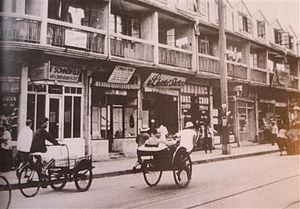| Shanghai Ghetto | |||||||||
|---|---|---|---|---|---|---|---|---|---|
 Seward Road in the ghetto in 1943 | |||||||||
| Chinese name | |||||||||
| Traditional Chinese | 上海難民營 | ||||||||
| Simplified Chinese | 上海难民营 | ||||||||
| |||||||||
| Restricted Sector for Stateless Refugees | |||||||||
| Traditional Chinese | 無國籍難民限定地區 | ||||||||
| Simplified Chinese | 无国籍难民限定地区 | ||||||||
| |||||||||
| Japanese name | |||||||||
| Kanji | 無国籍難民限定地区 | ||||||||
The Shanghai Ghetto, formally known as the Restricted Sector for Stateless Refugees, was an area of approximately one square mile (2.6 km2) in the Hongkou district of Japanese-occupied Shanghai (the ghetto was located in the southern Hongkou and southwestern Yangpu districts which formed part of the Shanghai International Settlement). The area included the community around the Ohel Moshe Synagogue. Shanghai was notable for a long period as the only place in the world that unconditionally offered refuge for Jews escaping from the Nazis.[1] After the Japanese occupied all of Shanghai in 1941, the Japanese army forced about 23,000 of the city's Jewish refugees to be restricted or relocated to the Shanghai Ghetto from 1941 to 1945[2] by the Proclamation Concerning Restriction of Residence and Business of Stateless Refugees. It was one of the poorest and most crowded areas of the city. Local Jewish families and American Jewish charities aided them with shelter, food, and clothing.[2] The Japanese authorities increasingly stepped up restrictions, surrounded the ghetto with barbed wire, and the local Chinese residents, whose living conditions were often as bad, did not leave.[3][4] By 21 August 1941, the Japanese government closed Shanghai to Jewish immigration.[5]
- ^ Wasserstein, B. Secret War in Shanghai (1999) at pp 140–150.
- ^ a b Shanghai Jewish History Archived 29 May 2010 at the Wayback Machine (Shanghai Jewish Center)
- ^ Shanghai Ghetto Shows a Hidden Piece of WWII History Archived 4 June 2011 at the Wayback Machine By Kimberly Chun (AsianWeek)
- ^ The Jews of Shanghai: The War Years Archived 8 March 2005 at the Wayback Machine, Murray Frost.
- ^ Avraham Altman, and Irene Eber. "Flight to Shanghai, 1938-1940: the larger setting." Yad Vashem Studies 28 (2000): 51-86. online